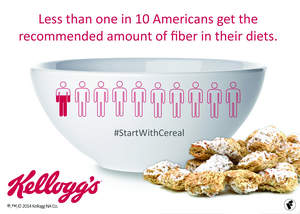MISSION, KS--(Marketwired - Mar 24, 2014) - (Family Features) Despite all the talk today about nutrition, the majority of adults are still lacking important nutrients in their diets. A key example is fiber and convenient, nutritious options, such as ready-to-eat breakfast cereal, can help fill the fiber gap and provide other important nutrients at the same time.
Less than one in 10 Americans get the recommended amount of fiber in their diets. According to the U.S. Department of Agriculture's (USDA) Agriculture Research Service, Americans' average intake of dietary fiber is low -- only 15 grams per day. This compares to the Institute of Medicine's recommendation that women need 25 grams per day and men should get 38 grams per day.
Recent research shows part of the reason for this fiber gap is because most people think they are already eating the recommended amount of fiber. In fact, 56 percent of Americans think they are getting enough fiber in their diet when, in reality, less than 10 percent are meeting the recommendations.
Studies also show that fiber may be beneficial in reducing the risk of many lifestyle-related diseases and has been associated with maintaining a healthy weight and digestive system.
Fortunately, you can easily increase fiber intake and take advantage of these health benefits by starting your day with a fiber-full ready-to-eat breakfast cereal.
Research from the USDA shows food companies are making positive changes to enhance the nutrition profile of ready-to-eat cereals. According to the study, fiber in breakfast cereals from major manufacturers increased 32 percent, while sugar and sodium decreased 10 percent and 14 percent, respectively, between 2005 and 2011.
"A 32 percent increase in fiber is a great way to help people fill their fiber gap," said Lisa Sanders, Ph.D., registered dietitian, director global nutrition and scientific affairs at Kellogg Company.
To get the best fiber boost, look for cereals that are a good or excellent source of fiber (3 or 5 grams, respectively). Generally, most of us think of bran cereals, shredded wheat and wheat flake cereals. But many of our favorites have more fiber than you think. Kellogg, for example, offers more ready-to-eat cereals that are a good source of fiber and include eight grams of whole grains than any other U.S. food company.
In addition to ready-to-eat breakfast cereal, round out your daily diet with other fiber-rich foods, such as beans, nuts (especially almonds, pecans and walnuts), berries and crunchy vegetables. Nuts and berries are also a great addition for breakfast cereal to pack an even bigger morning fiber punch.
Want to find out if you're getting enough fiber in your diet? Convenient tools also are available to help you track your fiber intake, such as Kellogg's Fiber Tracker mobile app, which can be found at http://www2.kelloggsnutrition.com/fiber-tracker-mobile.
About Family Features Editorial Syndicate
This and other food and lifestyle content can be found at www.editors.familyfeatures.com. Family Features is a leading provider of free food and lifestyle content for use in print and online publications. Register with no obligation to access a variety of formatted and unformatted features, accompanying photos, and automatically updating Web content solutions.
Contact Information:
Vickie Rocco
vrocco@familyfeatures.com
1-888-824-3337
http://editors.familyfeatures.com
